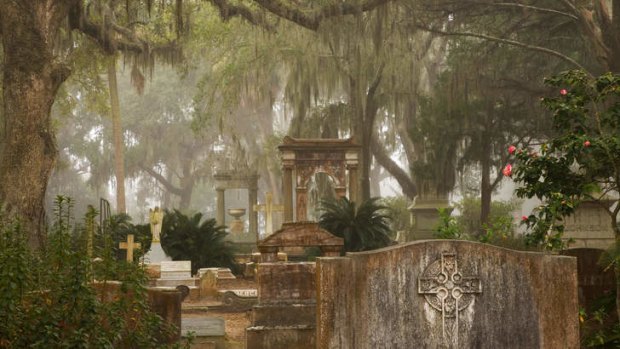
Historic Bonaventure Cemetery.Credit: Alamy
Two decades after the book that changed Savannah, Brigid Delaney discovers its enduring charms.
It's difficult to get to Savannah. It's not on the way to anywhere. You can't just happen to pass through it. It's cut off, otherworldly, and unlike anywhere else in America.
After travelling by bus from Atlanta, a five-hour trip that follows the interstate through to Georgia, I arrive full of anticipation and stories about the place.
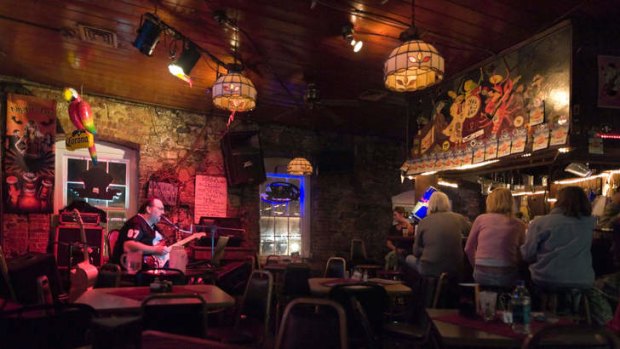
Bayou Cafe in the historic district.Credit: Alamy
Only a few people I know have been there, yet everyone who has read the book or seen the film Midnight in the Garden of Good and Evil feels as if they have visited Savannah, at least in their heads.
The Savannah of the book is a place of secrets, swamps, sorcery and sex. Locals walk imaginary dogs, keep flies on leashes and threaten to poison the town's water supply. They drink like fish, hold legendary parties, and commit notorious crimes.
At the centre of the book is a murder. In 1981, prominent local antique dealer Jim Williams was tried for the murder of his lover, a young employee named Danny Hansford. Locals described the victim as a "hot streak of sex". The story of that Savannah and the trials became a non-fiction sensation that read more like a racy novel.
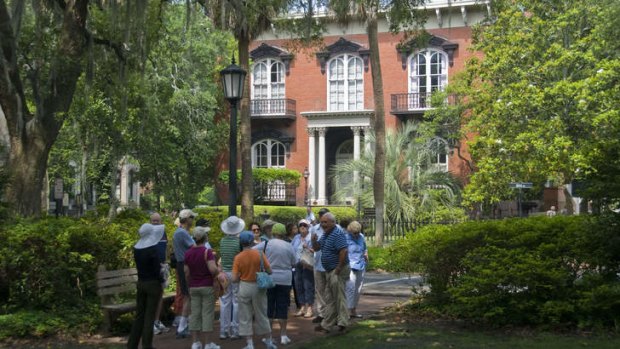
Tourists gather outside Mercer-Williams House in Savannah.Credit: Getty Images
It is now 20 years since New York journalist John Berendt penned the bestseller that stayed in The New York Times list for 216 weeks. Its success changed the town for good.
Before the book, Savannah used to be called "Slow-vannah", a stately but sleepy southern city that attracted tourists wanting to visit its historic squares and the birthplace of Girl Scouts founder Juliette Gordon Low.
By the mid-20th century, the cotton boom that had paid for all the pretty Italianate and Regency houses was well and truly over and the town had fallen on hard times. The beautiful squares were being turned into car parks and the wealthy families were, like a lot of Americans, deserting downtown for the suburbs.
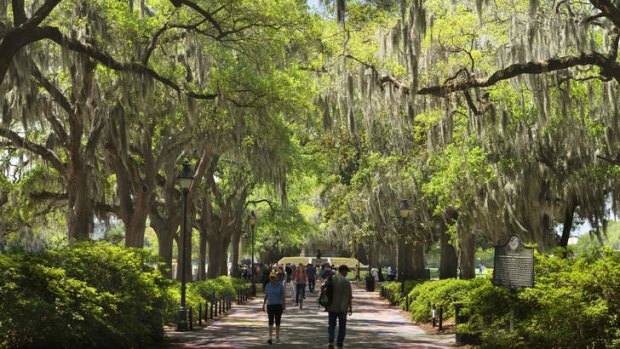
Spanish moss drapes park trees.Credit: Alamy
When American-born British personality Lady Astor visited Savannah after World War II, she described the town as looking like a "beautiful woman with a dirty face."
This jolted the locals, led by elderly society ladies, to start a preservation movement, buying back abandoned stately homes and attempting to restore Savannah to its former glory.
The restoration movement in Savannah was a success and was used as a model around the United States, but it was the book that put the town on the map, for better or worse. The publicity poured millions of dollars into the town over the years and created thousands of jobs, but as one local told me: "We liked being a secret. There are a lot of Savannahians who hate it [the attention] and wish it would just go away."
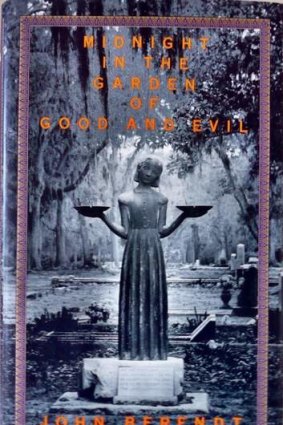
The Bird Girl statue on the book cover.
Berendt concluded his book by writing: "Savannah was invariably gracious to strangers, but it was immune to their charms. It wanted nothing so much as to be left alone ... For me, however, Savannah's resistance to change was its saving grace. The city looked inward, sealed off from the noises and distractions of the world at large."
From the bus depot, Savannah seems like any small American city, but once I walk downtown, its charms unfold like a concertina.
With a population of about 445,000, including a large student presence (there is a major art school, SCAD in Savannah), this could be the perfect American town. The streets, with their high-end boutiques, are full of shoppers. There are upmarket coffee shops and restaurants, chi-chi homeware shops and even a place that just sells honey.
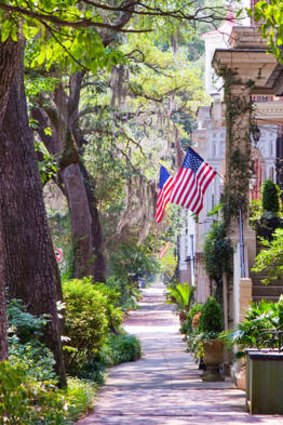
Historic mansions in the old town.Credit: Alamy
I can see why Berendt was so charmed he decided to live here on and off for eight years. Savannah could be just another yuppie weekend getaway but for the eccentricity and the hospitality of its people.
Locals tell me proudly it is one of only three cities in the US where you can drink on the streets. Buy a drink in Savannah and the barman will ask you if it's "to go or to stay?"
Despite the cold temperature, my Saturday night in Savannah is like some sort of street party. People with drinks walk around the waterfront, squares and cobbled streets, in and out of taverns, where live music spills out and strangers talk to you at the bar.
I get chatting to one local at the bar who is wearing a kilt. He is not Scottish. He just "felt like wearing it". I pass a billboard on the side of a club advertising a drag show for Lady Chablis, a character from Midnight in the Garden of Good and Evil. She is performing the week after I leave.
The next morning, I meet my guide. Kathy is a true Savannahian who leads Midnight in the Garden of Good and Evil tours. She is wrapped in a flamboyant fur reversible jacket, has enormous flaming red hair and a voice that has so much life and cadence that it's like listening to a song by one of the town's favourite sons, Johnny Mercer. He wrote Moon River, among many others, and it was in his old house where Danny Hansford was killed.
Kathy doesn't yell or use a microphone, as "I canna stand it when folk raise their voices in a cemetery." She talks softly.
"A lot of people's first introduction to Savannah is through Midnight," says Kathy. "I get people here from all over the world.
"Before, we had no tourist industry - only two trolley cars compared now with 30 buses, 46 walking tours and four horse-and-carriage companies.
"Right now", says Kathy, "the number one industry is the port. Number two is tourism. Number three is Gulfstream - private jets."
Kathy drives me past the squares, of which there are 22 in Savannah. They are picturesque and surrounded by impressive homes, churches, oak trees and the ubiquitous spanish moss.
"There are similar plant systems in Florida and New Orleans. We have more moisture. It makes everything grow like it's on steroids." It also gives the town a romantic, spooky air.
We drive on Victory Parade to Bonaventure Cemetery, eight kilometres from town. Spanish moss drips from the trees - "We call it 'gothic lace'," says Kathy - and the aged oaks form a canopy. Huge plantation-style houses sit back from the road.
I'm not a huge fan of cemetery visits, finding them a bit morbid, but this cemetery is special. Not only is it "one of the top cemeteries in the world", but it is the garden of good and evil in the title of Berendt's book.
"When I was a kid I used to play in the cemetery," says Kathy. "You came here by horse and carriage and brought a picnic. It's so purty. Twenty-nine miles of azaleas and in two months it's camellias." Her hand trails against the railings as she points out the intricate cast-iron gates around the plots.
The cemetery was once an old plantation, until the grand house burnt down on the night of a big party. The host moved everyone outside and they drank champagne as the house was destroyed.
"On still nights you can hear the sound of glass breaking from the last party," says Kathy.
In a scene straight out of the book, minus the shakers of martinis, Kathy and I sit on the grave of US Poet Laureate Conrad Aiken, who returned home to Savannah after many years away.
When he was a young boy, his father murdered his mother, then committed suicide. His grave, the bench we are sitting on, bears the legend "Cosmos Mariner - Destination Unknown".
There are very few people in the cemetery today but Kathy still thinks the place is over-run. She casts a contemptuous glance at a rival tour guide.
"I don't know her. She's not even from around here."
"It was pristine. It was a secret that had not been spoiled. Now there's a lot of disrespect. People ripped fingers off statues. That's because of the book," says Kathy.
So many book fans trampled across a family plot to see the Bird Girl statue, depicted on the book cover, that the statue was moved to a local museum.
The young man killed by Jim Williams wanted to be buried at Bonaventure. Kathy takes me to his grave in the newer cemetery next door. He has a modest grave, with 1960 to 1981 etched into stone. Many of the gravestones note how and where the person died. There are quite a few murders and many deaths out of town. Kathy hoots: "Have you noticed that everyone who goes to New York dies?"
One man who died in the north was William Gaston, famous for his hospitality when he was alive. He often had strangers stay at his place in Savannah.
When he died - in New York - his body was returned to Savannah, where his friends paid for his tomb.
If you came to Savannah and died without any kin, Gaston's hospitality continued: you were placed in the crypt with him until you were claimed.
Kathy asks who my favourite character in the book is. I nominate Emma Williams, the songstress who drove all around the county performing, often the hits of local crooner Johnny Mercer.
"Ah well, she died," says Kathy.
Kathy's favourite is Jim Williams, the antiques restorer who was remembered as the villain of the story. Williams died in 1991.
"Mamma worked in the dentist's and she was real purty and had men try and flirt with her all the time, but not Jim Williams.
"He was so handsome with coal-black eyes - and more handsome than Kevin Spacey," who played Williams in the film, she adds.
Kathy wants Williams to be remembered for his restoration work.
"He restored 60 homes in Savannah and seven outside. He was very hands on."
You can visit his house in Mercer Square, where his sister still lives in the upper level. Kathy says Williams believed in ghosts and had three exorcisms in a house he restored and lived in.
Late on Saturday night, walking back to my hotel, I pass small groups of people huddling around a guide with a torch. Some of them are carrying gadgets that pick up the electro-magnetic impulses of ghosts. As I said, it's a fairly eccentric place.
"The book put us on the map for touring, and the movie reinforced it, but a lot of people who take the tour haven't read the book," says Kathy. However, each new reader is a potential tourist.
On a bicycle tour the following day, I meet two 20-somethings from Florida. As we ride around the square, we stop in front of Jim William's house and as our guide starts talking about the murder, it's clear they have no idea what he is talking about. But they are fascinated.
"Don't tell us what happened!" they cry. "We want to read the book."
The writer stayed with assistance from Visit Savannah.
FIVE MORE PLACES PUT ON THE MAP BY BOOKS
Verona, Italy: Romeo and Juliet, by William Shakespeare.
Brighton, England: Brighton Rock, by Graham Greene.
Hanging Rock, Victoria: Picnic at Hanging Rock, by Joan Lindsay.
Kefalonia, Greece: Captain Corelli's Mandolin, by Louis de Bernieres.
Monterey, California: Cannery Row, by John Steinbeck.
TRIP NOTES
GETTING THERE
Qantas has a fare to Savannah for about $1905 low-season return from Sydney including tax. Fly to Dallas Fort Worth (14hr 10min) and then to Savannah (2hr 20min); see qantas.com.au or phone 131 313. Melbourne passengers pay about $30 more and fly Qantas to Sydney to connect.
STAYING THERE
Marriott Courtyard Savannah, 415 West Liberty St, Savannah, Georgia; phone 1 912 790 8287; from $79 per room per night, see marriott.com.
MORE INFORMATION
FIVE MORE THINGS TO DO IN SAVANNAH
THE WATERFRONT
While Savannah's squares are its calling card, along the water there's a wide range of accommodation, restaurants and (mostly touristy) shops. As Savannah's No. 1 industry is the port, on a warm day it's easy to while away the hours at a quayside bar, watching the ships roll in.
GHOST TOUR
While many are attracted to Savannah's history, many also come for ghost hunting. On my tour, a guide tells me Savannah is the most haunted town in America. We visit an old hold down at the port where slaves were held and died, spooky rooms in old inns where duels took place and a pub where a fire ripped through, leaving ghosts and spirits to haunt the halls.
ISLE OF HOPE
A short drive out of town is a string of beautiful barrier islands, where celebrities such as Sandra Bullock and John Cougar have houses. We explored the Isle of Hope, with its beautiful homes right on the water.
BARBECUE FEAST
I had a full diner breakfast at Clarys (featured prominently in the book Midnight in the Garden of Good and Evil) and the mother of all barbecue feeds at Angels. The shack seats less than 20 diners, and is down a laneway behind a bin. Grab the brisket or pulled pork sandwiches and double cooked fries. Douse in hot sauce. Consume.
WORMSLOE PARK
A national park a short distance from Savannah, it's a gorgeous avenue of old oaks and Spanish moss. You don't need to pay the entrance fee to appreciate the trees. One of the best photographs can be taken at the Gothic gates.
Sign up for the Traveller Deals newsletter
Get exclusive travel deals delivered straight to your inbox. Sign up now.